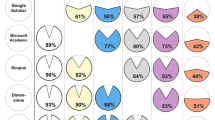Abstract
The construction of virtual science landscapes based on citation networks and the strategic use of the information therein shed new light on the issues of the evolution of the science system and possibilities for control. Citations seem to have a key position in the retrieval and valuation of information from scientific communication networks.Leydesdorff's approach to citation theory takes into account the dual-layered character of communication networks and the second-order nature of the science system. This perspective may help to sharpen the awareness of scientists and science policy makers for possible feedback loops within actions and activities in the science system, and probably nonlinear phenomena resulting therefrom. In this paper an additional link to geometrically oriented evolutionary theories is sketched and a specific landscape concept is used as a framework for some comments.
Similar content being viewed by others
References
H. Small, B. C. Grifith, The Structure of Scientific Literature I: Identifying and Graphing Specialties,Science Studies, 4 (1974) 17–40.
M. Callon, J. Law, A. Rip (Eds),Mapping the Dynamics of Science and Technology, Macmillan, London, 1986.
I. V. Marshakova,Sistema Tsitirovaniya, Nauka, Moscow, 1988.
H. Small Update on Science Mapping: Creating Large Document Spaces,Scientometrics, 38 (1997) No. 2, 275–293.
E. C. M. Noyons, A.F.J. Van Raan Advanced Mapping of Science and Technology,Scientometrics, 41 (1998) Nos 1–2, 61–67.
Cf. URL: http://sahara.fsw.LeidenUniv.nl/cwts/cwtshome.html
H. Small, A General Framework for Creating Large-Scale Maps of Science in Two or Three Dimensions: The Sci Viz System,Scientometrics, 41 (1998) Nos 1–2, 125–133.
C. Macilwain, As Citation ‘Landscape’ Takes Shape,Nature, 383 (1996) No. 6602, 659.
See URL: http://www.cs.sandia.gov/projects/VxInsight/Vxfull.html
See URL: http://www.sandia.gov/LabNews/LN10-11-96/land.htm
See URL: http://www.sandia.gov/media/mapping.htm
E. Garfield,Citation Indexing-its Theory and Application in Science, Technology and Humanities, Wiley, New York, 1979.
M. Bonitz, Science Citation Index on CD-ROM: The Largest Expert System in the World,International Forum on Information and Documentation, 15 (1990) No. 3, 9–12.
P. Weingart, Wissenschaftsindikatoren als soziale Konstruktion und ihre Realität, in:P. Weingart, R. Sehringer, M. Winterhager (Eds),Indikatoren der Wissenschaft und Technik, Campus, Frankfurt/M., New York, 1990, pp. 224–232.
E. Garfield,Essays of an Information Scientist, Vols. 1–15, ISI Press, Philadelphia, 1977–1993.
W. Krohn, G. Küppers,Die Selbstorganisation der Wissenschaft (Suhrkamp, Frankfurt/M., 1989.
V. Bush, As We May Think,Atlantic Monthly, 176 (1945) No. 1, 101–108.
H. M. Voigt, W. Ebeling, I. Rechenberg, H.-P. Schwefel (Eds),Parallel Problem Solving From Nature-PPSN IV, Springer, Berlin, 1996.
P. W. Anderson, Local Moments and Localized States,Reviews of Modern Physics, 50 (1978) No. 2, 191–201.
W. Fontana, P. F. Stadler, E. G. Bornberg-Bauer, T. Griesmacher, M. Hofacher, P. Tacker, P. Tarazona, E. D. Weinberger, P. Schuster, RNA-Folding and Combinatory Landscapes,Physical Review E, 47 (1993) No. 3, 2083–2099.
I. Rechenberg,Evolutionsstrategie 94, Fromman-Holzboog, Stuttgart, 1994.
H.-P. Schwefel,Evolution and Optimum Seeking, Wiley, New York, 1995.
R. Feistel, W. Ebeling, Models of Darwin Processes and Evolution Principles,BioSystems, 15 (1982) No. 4, 291–299.
R. Feistel, W. Ebeling,Evolution of Complex Systems, Kluwer, Dordrecht, 1990.
E. Bruckner, Evolutionsstrategie und Forschungsstrategie, Berlin, 1991 (mimeo).
W. Umstätter, Die evolutionsstrategische Entstehung von Wissen, in: Deutsche Sektion der Internationalen Gesellschaft für Wissensorganisation e.V. (Ed),Fortschritte in der Wissensorganisation, Bd. 2, INDEKS, Frankfurt/M., 1992, pp. 1–11, see also URL: http://hub.ib.hu-berlin.de:80/∼wumsta/pub66.htm
E. Bruckner, W. Ebeling, A. Scharnhorst, The Application of Evolution Models in Scientometrics,Scientometrics, 18 (1990) Nos 1–3, 21–41.
K. Mainzer,Thinking in Complexity, 3rd ed., Springer, Berlin, 1997.
W. Ebeling, A. Scharnhorst, M. A. Jiménez Montaño, Karmeshu, Evolutions- und Innovationsdynamik als Suchprozeß in komplexen adaptiven Landschaften, Berlin, 1998 (mimeo).
W. Ebeling, Karmeshu, A. Scharnhorst, Economic and Technological Search Processes in a Complex Adaptive Landscape, in:J. Kertesz, I. Kondor (Eds),Econophysics, Kluwer, Dordrecht, 1998 (in press).
H. Rosé, Evolutionäre Strategien und Multitome Optimierung, Dissertation, Humboldt-Universität zu Berlin, 1998, see also URL: http://www.summa.physik.hu-berlin.de/∼rose
S. Wright, The Roles of Mutation, Inbreeding, Crossbreeding and Selection in Evolution,Proceedings of the Sixth International Congress on Genetics, 1 (1932) No. 6, 356–366.
G. N. Gilbert, A Simulation of the Structure of Academic Science,Sociological Research Online, 2, 1997. see URL:http://www.socresonline.org.uk/socresonline/2/2/3.html
A. Rip, Qualitative Conditions of Scientometrics: the New Challenges,Scientometrics, 38 (1997) 7–26.
F. Osareh, Bibliometrics, Citation Analysis and Co-Citation Analysis: a Review of Literature I, II,Libri, 46 (1996) No. 3, 149–158, No. 4, 217–225.
S. K. Sen, Theoretical Issues in Citation process: a Review,The International Journal of Scientometrics and Informetrics, 2 (1996) No. 2-3, 159–198.
G. Böhme, W. van den Daele, W. Krohn, Die Finalisierung der Wissenschaft,Zeitschrift für Soziologie, 2 (1973) No. 2, 128–144.
H. Small, E. Garfield, The Geography of Science: Disciplinary and National Mapping,Journal of Information Science, 11 (1985) No. 4, 147–159.
T. Braun, A. Schubert, Dimensions of Scientometric Indicator Datafiles: World Science in 1990–1994,Scientometrics, 38 (1997) No. 1, 175–204.
E. C. M. Noyons, Landschappen Van Wetenschap,Afleiding, 1 (1997) 5–9.
E. Bruckner, W. Ebeling, M. A. Jiménez Montaño, A. Scharnhorst, Nonlinear Stochastic Effects of Substitution-an Evolutionary Approach,Journal of Evolutionary Economics, 6 (1996) No. 1, 1–30.
B. Joerges, T. Shinn,Instrumentation for Science, State and Industry, Haarwood, Chur, Reading, 1999 (to appear).
Author information
Authors and Affiliations
Additional information
Comments on Theories of Citation?L. Leydesdorff,Scientometrics, 43 (1998) No. 1.
Rights and permissions
About this article
Cite this article
Scharnhorst, A. Citation-networks, science landscapes and evolutionary strategies. Scientometrics 43, 95–106 (1998). https://doi.org/10.1007/BF02458399
Received:
Issue Date:
DOI: https://doi.org/10.1007/BF02458399




